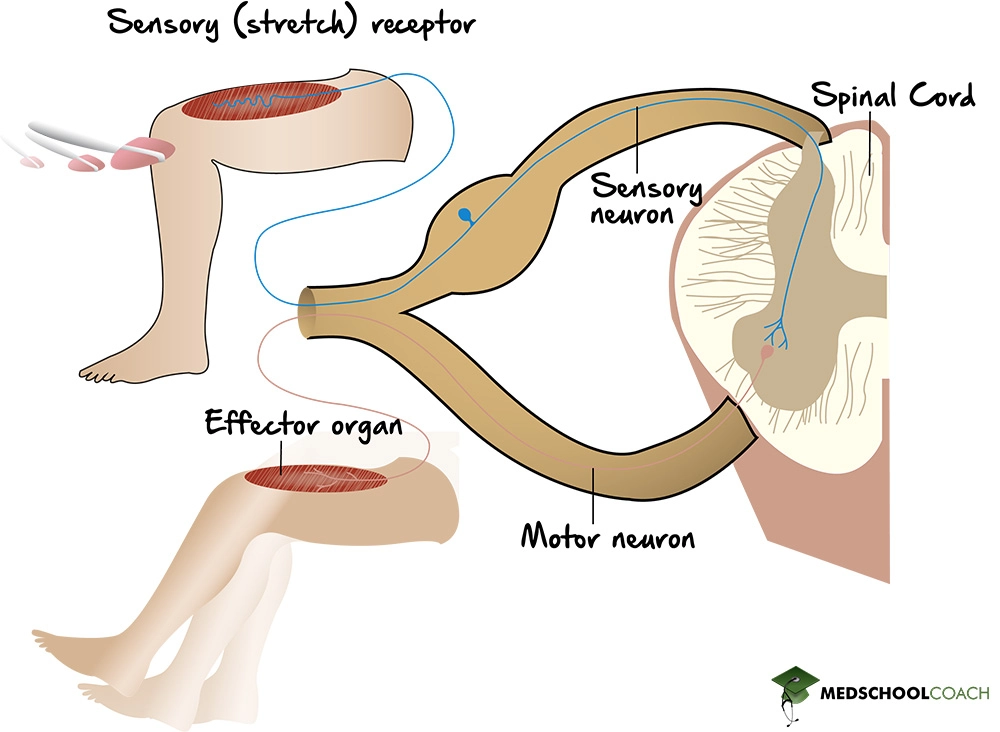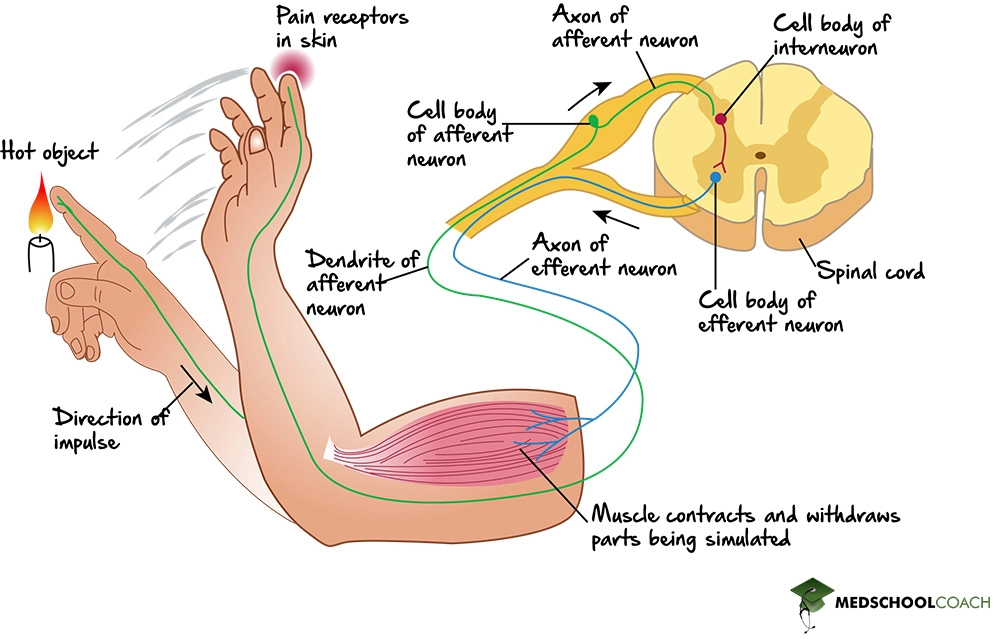Reflex Arcs
MCAT Biology - Chapter 2 - Section 1.3 - Organ Systems - Reflex Arcs
- Home
- »
- MCAT Masterclass
- »
- Biological and Biochemical Foundations of Living Systems
- »
- Biology
- »
- Reflex Arcs – MCAT Biology
Sample MCAT Question - Reflex Arcs
What is the primary difference between monosynaptic and polysynaptic reflex arcs?
a) Monosynaptic reflex arcs include interneurons
b) Polysynaptic reflex arcs include several afferent neurons
c) Monosynaptic reflex arcs do not have efferent neurons
d) Polysynaptic reflex arcs include interneurons
D is correct. Polysynaptic reflex arcs include interneurons.
During a reflex feedback loop, when information is integrated in the spinal cord, it can interact with interneurons located in the spinal cord, or it can synapse directly onto a motor neuron. This pathway variation is the primary difference between a monosynaptic and polysynaptic reflex. In a monosynaptic reflex, there is no involvement of interneurons. Instead, the signal enters the spinal cord through a sensory neuron and synapses directly with a motor neuron. An example of this type of reflex is the patellar reflex. In a polysynaptic reflex, however, when the sensory neuron enters the spinal cord, it first interacts with an interneuron, which then synapses with a motor neuron. An example of this type of reflex is the response to harmful or painful stimuli, such as a burn or cut.
Get 1-on-1 MCAT Tutoring From a Specialist
With MCAT tutoring from MedSchoolCoach, we are committed to help you prepare, excel, and optimize your ideal score on the MCAT exam.
For each student we work with, we learn about their learning style, content knowledge, and goals. We match them with the most suitable tutor and conduct online sessions that make them feel as if they are in the classroom. Each session is recorded, plus with access to whiteboard notes. We focus on high-yield topics if you’re pressed for time. If you have more time or high-score goals, we meticulously cover the entire MCAT syllabus.
Reflex Arcs
The neural pathway for reflexes, starting from a sensory stimulus to the motor response, is called a reflex arc. In general, all reflexes follow the same steps. First, a sensory neuron detects a stimulus and sends a signal to the spinal cord. Within the spinal cord, the signal is integrated by an interneuron, which then sends another signal to a motor neuron. Lastly, the motor neuron sends a signal to the muscle which will then produce a response.
Afferent & Efferent Neurons
Sensory neurons are also known as afferent neurons. The word “afferent” means “towards”. Sensory neurons are called afferent neurons because they send signals towards the spinal cord. Motor neurons, on the other hand, are also known as efferent neurons. The word “efferent” means “away”. Motor neurons are called efferent neurons because they send signals away from the spinal cord. A useful mnemonic to use to remember the difference between afferent and efferent neurons is SAME: Sensory, Afferent/Motor, Efferent.
Monosynaptic Reflexes
Not all reflexes involve all of the above steps. In particular, the second step involving an interneuron is not present in some reflexes. One example is the patellar reflex, also known as the “knee jerk” reflex, which is shown in Figure 1. When the patellar tendon, located below the knee is tapped, the quadriceps muscle fires and the knee extends. The steps involved in this reflex are as follows: first, an action potential travels along the sensory neuron to the spinal cord. At the spinal cord, the sensory neuron synapses directly onto the motor neuron. The motor neuron then sends a signal that elicits the contraction of the quadriceps muscle. Since this reflex involves only one synapse, it is known as a monosynaptic reflex.

Polysynaptic Reflexes
Most reflexes, however, are not monosynaptic. Instead, they are polysynaptic. Figure 2 shows that in a polysynaptic reflex, a sensory neuron detects a stimulus and sends a signal to the spinal cord. In the spinal cord, the sensory neuron synapses onto an interneuron, which integrates the signal and sends a new signal to a motor neuron, which in turn elicits a motor response. So polysynaptic reflexes involve one or more interneurons connecting the afferent and efferent signals. Most reflexes are complicated polysynaptic reflexes that involve multiple interneurons.

Explore More MCAT Masterclass Chapters
Take a closer look at our entire MCAT Masterclass or explore our Biochemistry lessons below.

One-on-One Tutoring
Are you ready to take your MCAT performance to a whole new level? Work with our 99th-percentile MCAT tutors to boost your score by 12 points or more!
See if MCAT Tutoring can help me
Talk to our enrollment team about MCAT Tutoring

MCAT Go Audio Course
Engaging audio learning to take your MCAT learning on the go, any time, any where. You'll be on the way to a higher MCAT score no matter where you are. Listen to over 200+ lessons.

MCAT Practice Exams
Practice makes perfect! Our mock exams coupled with thorough explanations and in-depth analytics help students understand exactly where they stand.

MCAT Prep App
Access hundreds of MCAT videos to help you study and raise your exam score. Augment your learning with expert-created flashcards and a question banks.